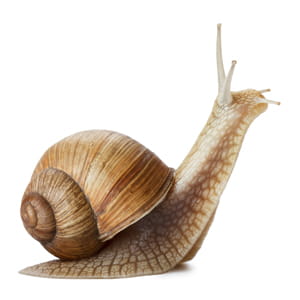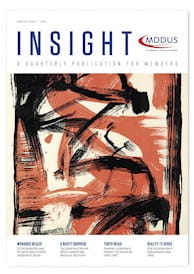
PAISLEY may be known for its patterns and its shawls, but this town to the west of Glasgow has another claim to fame, at least for those interested in the law. It was here, 90 years ago, that one of the most important legal decisions in history, and one that still has implications for clinical practice today, had its origins.
A COOL GINGER BEER
On the summer evening of 26 August 1928, Mrs May Donoghue, a shop assistant from the East End of Glasgow, took a tram ride to Paisley. There she met a friend at the Wellmeadow Café and they decided to quench their thirst. Her friend bought the refreshments and Mrs Donoghue was served a glass containing ice cream over which the waiter poured a portion of a bottle of ginger beer to make an iced drink, or float. After Mrs Donoghue drank some, her friend added more ginger beer from the dark glass bottle that had been left on the table. As she poured, Mrs Donoghue noticed something fall into the glass, which she recognised as a decomposing snail. Understandably, she immediately felt sick and became “shocked and ill”.
Mrs Donoghue was clearly affected by the event and sought medical treatment three days later from her own doctor, and again three weeks later in mid-September at Glasgow Royal Infirmary.
LEGAL CASE
Because it was her friend who had purchased the ginger beer, Mrs Donoghue had no contractual relationship with the café owner. She would later learn that the only party she might sue would be the manufacturer of the drink, David Stevenson, whose name was clearly written on the dark glass bottle in large white lettering. Moreover, she would have to prove negligence on his part if she was to recover any damages, and that claim of negligence would require there to be a duty of care between her and Stevenson.
The law at the time supported the existence of a duty of care to people harmed by the negligent acts of others, but only in very limited circumstances. These would include instances where a contract existed between the parties, if the manufacturer was acting fraudulently or if the product was inherently dangerous. In Mrs Donoghue’s case, none of these applied, but she was determined to seek such damages and engaged the Glasgow solicitor Walter Leechman.
Interestingly, Leechman’s firm had represented the unsuccessful pursuers in two recent similar “mouse in ginger beer” cases. It seems more than a coincidence that of all the lawyers Mrs Donoghue might have consulted, the one she chose had both the experience and the resolve to pursue such a case. Quite how she found him, or was directed to him, remains a mystery.
Leechman issued a writ against Stevenson claiming damages of £500 plus costs and noting that “snails and the slimy trails of snails were frequently found” in the factory where his ginger beer was manufactured and bottled. Stevenson’s counsel moved the Court of Session to dismiss the claim and were eventually successful. Leechman then began the process of appealing the decision to the House of Lords. However, Mrs Donoghue had no money. Not only had she to declare herself in writing as a pauper so she could be absolved of the need to post security to cover any costs if her appeal was unsuccessful, but her counsel had to proceed in representing her without any guarantee of payment.
NEIGHBOUR PRINCIPLE
On 10 December 1931, five Law Lords met to hear the first of two days' arguments in Mrs Donoghue’s case. Some five months later they delivered their judgement and by a majority of three to two they agreed she did have a case. Mrs Donoghue, they ruled, was owed a duty of care by the manufacturer and bottler of the ginger beer and she could bring an action against him. This duty of care was founded on the "neighbour principle", eloquently expounded by one of the Law Lords, Lord Atkin. He summarised this principle in the ruling as follows:
"The rule that you are to love your neighbour becomes in law, you must not injure your neighbour; and the lawyer’s question, Who is my neighbour? receives a restricted reply. You must take reasonable care to avoid acts or omissions which you can reasonably foresee would be likely to injure your neighbour. Who, then, in law, is my neighbour? The answer seems to be—persons who are so closely and directly affected by my act that I ought reasonably to have them in contemplation as being so affected when I am directing my mind to the acts or omissions which are called in question."
The "lawyer’s question" referred to was the one asked of Jesus in Luke’s Gospel, and which prompted Christ to tell the parable of the Good Samaritan. Indeed, Lord Atkin’s ruling was firmly based on his reading of Judeo-Christian scripture.
DUTY OF CARE TODAY
The importance of this ruling lay in its implications for our understanding of negligence. Three criteria in law must be met for there to be medical negligence. First, a doctor must owe a duty of care to the patient in question. Second, there must be a breach of that duty of care. And third, the breach must result in harm to the patient. Thus, the concept of "duty of care" is central to our understanding of negligence, and it may be defined as an obligation we hold to take care to prevent harm being suffered by others. In defining to whom we owe this duty of care as our "neighbour", Lord Atkin created a new basis for the law of negligence, and of course his wide definition of neighbour would certainly include any doctor’s patient.
Not long after the House of Lords had ruled that Mrs Donaghue would be entitled to recover damages if she could prove what she alleged regarding the snail, David Stevenson died. His executors agreed an out of court settlement of £200 (almost £10,000 today) and as such the case never went to trial. May Donoghue died in 1958, perhaps unaware of the global impact that summer evening trip to Paisley had had some 30 years earlier.
Today, in Paisley you will find a small park, a bench and a memorial stone at the corner of Well Street and Lady Lane where the café once stood. Most locals know little of its significance, but occasionally you will see a stranger standing reading the inscription on the stone. Often they will be lawyers, sometimes doctors, who have made the pilgrimage from England or North America or from even further afield, just so they can stand on the spot where duty of care and the concept of negligence began.
POSTSCRIPT
In everything that has been written about this case, including all of the original legal documents, the bottle in question is said to have contained "ginger beer". What is perhaps not widely known is that the term “ginger” is a colloquialism in Glasgow for any fizzy drink. It is possible that in reality the bottle did not contain true “ginger beer” but some other form of flavoured, aerated water such as orangeade, referred to by Mrs Donoghue and her friend as “ginger”. Whether the bottle contained a snail at all is also a subject of controversy.
Some have argued that Mrs Donoghue’s claim was just a hoax to extort compensation. Whatever the truth of the contents of that bottle, it remains the reason for our understanding of negligence around the world.
Dr Allan Gaw is a writer and educator in Glasgow
SOURCES
- Donoghue v Stevenson [1932] AC 562 at 580. HL
- Taylor MR. Mrs Donoghue’s Journey http://www. scottishlawreports. org.uk/resources/dvs/ mrs-donoghue-journey. html [Accessed 20 March 2018]
- Bryden D, Storey I. Continuing Education in Anaesthesia Critical Care & Pain. 2011; 11: 124-7
This page was correct at the time of publication. Any guidance is intended as general guidance for members only. If you are a member and need specific advice relating to your own circumstances, please contact one of our advisers.
Read more from this issue of Insight

Save this article
Save this article to a list of favourite articles which members can access in their account.
Save to library


